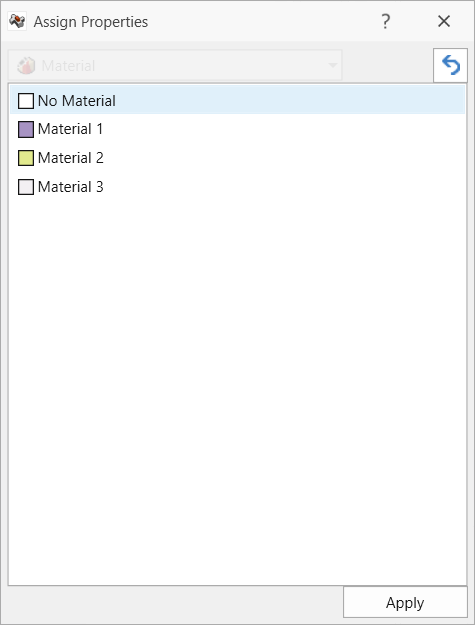Assign Materials
By default, when you initially define your model boundaries, the properties of the first material in the Material Properties dialog will automatically be assigned to all regions of the model. However, in general, it will be necessary for the user to assign the desired material properties to the different material regions of your model.
There are three ways to assign Material Properties:
- Select Materials > Assign Materials
 to open the Assign Properties dialog.
to open the Assign Properties dialog. - Select the desired geometry. In the Properties Pane, the current Applied Property is displayed. A new Material Property can be assigned to the selected geometry by changing the material selected from the Applied Property dropdown list.
- The Assign Materials Using Cutting Plane
 option allows you to assign materials to a 3D model using a moveable 2D
section plane. You can click on regions in the 2D section plane to
assign materials to the 3D model.
option allows you to assign materials to a 3D model using a moveable 2D
section plane. You can click on regions in the 2D section plane to
assign materials to the 3D model.
Assign Properties dialog
To assign Material Properties with the Assign Properties dialog:
- Select the Geometry
 workflow tab
workflow tab - Select Assign Materials
 from the toolbar or the Materials menu.
from the toolbar or the Materials menu. - Make sure that Materials is selected in the drop-list at the top of the Assign Properties dialog.
- Staging - if your model is multi-stage, in most cases material properties should be assigned at the first stage, therefore make sure that the Stage 1 tab is selected. (See below for more information about staged material property assignment.)
- In the dialog, select a Material you would like to assign.
- In the view window, place the cursor inside a Material zone in your model, click, and select Apply. You will see that the zone change to the colour of the assigned Material.
- To assign the same Material to other areas of the model, repeat Step 5 as necessary. You may need to zoom or pan the view, in order to accurately select regions to assign.
- If your model has multiple Material types, repeat steps 4 to 6 to assign the desired Materials to all the zones of the model.
- When you are finished with the Assign Properties dialog, you can close it by selecting the X in the dialog, or by pressing Escape.

Properties Pane
To assign material properties using the Properties Pane:
- Select the Geometry
 workflow tab.
workflow tab. - Select Entity Selection
 as the Selection Mode.
as the Selection Mode. - Select the geometry for which to assign a different material property.
- You can click directly on geometry in one of the Viewports, OR
- Select the geometry to edit in the Visibility Pane.
- In the Properties Pane, select the desired Material Property from the Applied Property drop down list.
- The selected Material Property will be applied to the selected geometry.
Assign Materials Using Cutting Plane
This option allows you to assign material properties to a 3D model using a moveable 2D section plane. You can click on regions in the 2D section plane to assign materials to the 3D model. See the Assign Material Using Cutting Plane topic.
Staged Assignment of Material Properties
In most cases, when materials are assigned to a multi-stage model, the assignment is applied at Stage 1, and the material type (for a given region) remains the same for all stages.
However, RocTunnel3 allows material properties to be assigned at any stage. This allows you to change material properties at different stages. This can be used for various purposes, for example:
- To model staged excavations
- The assigning of a backfill material after a region has been excavated
- To model a change of material properties with staging (e.g., to simulate changes in material unit weight).
When you assign material properties to a multi-stage model, it is important to understand how the assignment is applied:
- The material assignment is applied to the currently viewed stage and (by default) automatically propagated to all subsequent stages.
- The material assignment does not apply to stages before the current stage (i.e., the material type will remain unchanged in earlier stages).
Some examples of staged assignment of material properties are given below.
TO ASSIGN EXCAVATION
You can set a region as excavation by assigning the material property as No Material - you will see that no material appears in the excavated region.
TO ASSIGN BACKFILL
You can backfill an excavated region by assigning another material to the region at any stage after the excavated stage – you will see that the material colour reappears in the excavated region.
In the case of backfill, the number of times that a region would typically be assigned properties is three – the initial material assignment, the excavated assignment, and a final material assignment, representing backfill.
TO CHANGE MATERIAL PROPERTIES
In the most general case, you can assign a succession of different material types at different stages, to a given region. This can be used to simulate changes in unit weight, or other hydraulic conditions, with staging.
In this case, you must remember to assign materials starting with earlier stages and progressing to later stages, since a given material assignment will propagate from the current stage to all later stages (unless you use the This Stage Only option, see below).
ASSIGN TO CURRENT STAGE ONLY
In some cases, you may wish to assign a material type to a given stage, without propagating the assignment to subsequent stages. For this purpose, you can select the This Stage Only checkbox in the Assign Properties dialog.
If you select This Stage Only and then assign a material type, the assignment will only apply to the currently selected stage, and will not propagate to subsequent stages.